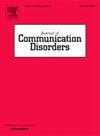有和没有自闭症的阿拉伯语儿童的语言、心理理论和认知技能:来自网络和聚类分析的证据。
IF 2.1
3区 医学
Q2 AUDIOLOGY & SPEECH-LANGUAGE PATHOLOGY
引用次数: 0
摘要
简介:自闭症谱系障碍(ASD)的特征是社会互动、社会沟通障碍,以及重复和刻板的行为模式。先前的研究报告了关于ASD儿童的语言(即音韵学、形态语法、词汇和语用学)、心理理论(ToM)、执行功能(EFs)和中心连贯测量之间的联系的混合发现。方法:163名4 ~ 11岁的巴勒斯坦-阿拉伯语儿童,其中ASD患儿76名,典型语言发育患儿87名。评估了儿童的语音、形态句法、词汇和语用技能,以及口头和非口头的ToM能力。此外,认知评估包括非语言智商、EF和中央连贯处理。结果:组水平结果显示,ASD患儿的各项指标均低于TLD患儿。网络分析显示,两组学生的语言、认知能力和认知能力之间存在密切联系。在自闭症儿童中,语言是中心节点,语用学比词法和词汇更重要,而年龄在TLD组中是中心节点。聚类分析确定了ASD群体中的四个语言集群,表明语言领域之间存在分离:(1)所有领域的高表现;(2)语音和形态句法的中等表现,语用能力低;(3)语音和词汇的中等表现,形态句法和语用能力低;(4)语音和词汇的中等表现,形态句法和语用能力极差。语言能力增强的自闭症儿童在言语和非言语ToM和EF任务中表现更好。结论:我们的研究结果强调了自闭症儿童在语言、ToM和认知方面的可变性,显示了一些自闭症儿童在不同领域内部和之间的分离。这些结果为应用干预措施提供了见解。本文章由计算机程序翻译,如有差异,请以英文原文为准。
Language, theory of mind and cognitive skills in Arabic-speaking children with and without autism: Evidence from network and cluster analyses
Introduction
Autism spectrum disorder (ASD) is characterized by impairments in social interactions, social communication, and repetitive and stereotyped patterns of behavior. Previous studies have reported mixed findings regarding the links between language (i.e., phonology, morphosyntax, lexicon, and pragmatics), theory of mind (ToM), executive functions (EFs), and central coherence measures in children with ASD.
Methods
A total of 163 Palestinian-Arabic-speaking children aged 4–11 participated: 76 with ASD and 87 with typical language development (TLD). The children`s phonological, morphosyntactic, lexical, and pragmatic skills, along with verbal and non-verbal ToM abilities were evaluated. Additionally, cognitive assessments included non-verbal IQ, EF, and central coherence processing.
Results
Group-level results showed that children with ASD scored lower than their TLD peers in all measures. Network analysis revealed robust interconnections between language, ToM, and cognitive skills in both groups. In autistic children, language was a central node, with pragmatics prevailing over morphosyntax and lexicon, while age was central in the TLD group. Cluster analysis identified four language clusters within the ASD group, demonstrating dissociations between language domains: (1) high performance across all domains, (2) moderate performance in phonology and morphosyntax with low pragmatic abilities, (3) moderate performance in phonology and lexicon with low morphosyntax and pragmatics, and (4) moderate phonology and lexicon with extremely poor morphosyntax and pragmatics. Autistic children with enhanced language abilities performed better in verbal and non-verbal ToM and EF tasks.
Conclusions
Our findings underscore the variability in language, ToM, and cognitive profiles of autistic children, showing dissociation within and between different domains in some autistic children. These results offer insights for applied interventions.
求助全文
通过发布文献求助,成功后即可免费获取论文全文。
去求助
来源期刊

Journal of Communication Disorders
AUDIOLOGY & SPEECH-LANGUAGE PATHOLOGY-REHABILITATION
CiteScore
3.30
自引率
5.90%
发文量
71
审稿时长
>12 weeks
期刊介绍:
The Journal of Communication Disorders publishes original articles on topics related to disorders of speech, language and hearing. Authors are encouraged to submit reports of experimental or descriptive investigations (research articles), review articles, tutorials or discussion papers, or letters to the editor ("short communications"). Please note that we do not accept case studies unless they conform to the principles of single-subject experimental design. Special issues are published periodically on timely and clinically relevant topics.
 求助内容:
求助内容: 应助结果提醒方式:
应助结果提醒方式:


